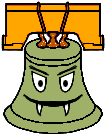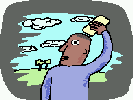Bells and Whistles
Here is a list of suggestions for extending the program for extra credit. You are encouraged
to come up with your own extensions. We're always interested in seeing
new, unanticipated ways to use this program!
![[whistle]](whistle.gif) To give your paintings
more variety, add some additional brush types to the program. These brush
strokes should be substantially different from those you are required
to implement. You will get one whistle for each new brush (within reason). To give your paintings
more variety, add some additional brush types to the program. These brush
strokes should be substantially different from those you are required
to implement. You will get one whistle for each new brush (within reason).
Example brush: 
![[whistle]](whistle.gif) The skeleton program
allows the user to paint outside the boundary of the paint rectangle, then
erases this region when the stroke is completed. Change this to clip brush
strokes to the region as they're being painted. The skeleton program
allows the user to paint outside the boundary of the paint rectangle, then
erases this region when the stroke is completed. Change this to clip brush
strokes to the region as they're being painted.
![[whistle]](whistle.gif) When using your
program, you currently can't see what part of the original image you're
painting. Extend the program so that when the cursor is in the painting
window, a marker appears on the original image showing where you're painting. When using your
program, you currently can't see what part of the original image you're
painting. Extend the program so that when the cursor is in the painting
window, a marker appears on the original image showing where you're painting.
![[whistle]](whistle.gif) Sometimes it is
useful to use the contents of the painting window as the original
image. Add a control to swap the contents of the painting window and the
contents of the original image window. Sometimes it is
useful to use the contents of the painting window as the original
image. Add a control to swap the contents of the painting window and the
contents of the original image window.
![[whistle]](whistle.gif) For your filter kernel, add a "normalize" checkbox that will automatically
divide by the sum of the weights when the user wishes it.
For your filter kernel, add a "normalize" checkbox that will automatically
divide by the sum of the weights when the user wishes it.
![[bell]](bell.gif) Add controls that allow
you to manipulate the color of the image. For example, you could implement
independent scaling of the red, green, and blue channels. Add controls that allow
you to manipulate the color of the image. For example, you could implement
independent scaling of the red, green, and blue channels.
![[bell]](bell.gif) Design a brush that selectively
applies one or more filters from your filter kernel. This might require some UI
changes to your filter kernel UI. Design a brush that selectively
applies one or more filters from your filter kernel. This might require some UI
changes to your filter kernel UI.
Note: you must take into account the brush size.
![[bell]](bell.gif) Add an undo feature with
at least one level of undo so that you can try a brush and decide to undo
its effect on the canvas. This comes in very handy for experimenting with
brush and filtering effects. Add an undo feature with
at least one level of undo so that you can try a brush and decide to undo
its effect on the canvas. This comes in very handy for experimenting with
brush and filtering effects.
![[bell]](bell.gif) Add the ability to
dissolve one image into another. Add the ability to
dissolve one image into another.
![[bell+whistle]](bell_whistle.gif) A different
solution to the problem of not being able to see where you're painting
is to show a dimmed version of the painting on the canvas. Add a slider
that allows the user to fade in or fade out the original image beneath
the user's brush strokes on the canvas. (Beware, this bell and whistle
is more difficult than it looks). A different
solution to the problem of not being able to see where you're painting
is to show a dimmed version of the painting on the canvas. Add a slider
that allows the user to fade in or fade out the original image beneath
the user's brush strokes on the canvas. (Beware, this bell and whistle
is more difficult than it looks).
![[bell+whistle]](bell_whistle.gif) Add a
"mural" effect to your Impressionist by implementing the ability to load
in different images while preserving what has been drawn on the canvas.
Add a "New Mural Image" or "Change Mural Image" to the controls window
that allows the user to change images. The user may then load an image,
draw in what he / she prefers on the canvas, and then load a different
image and continue drawing on the canvas; thus, a "mural" effect. Add a
"mural" effect to your Impressionist by implementing the ability to load
in different images while preserving what has been drawn on the canvas.
Add a "New Mural Image" or "Change Mural Image" to the controls window
that allows the user to change images. The user may then load an image,
draw in what he / she prefers on the canvas, and then load a different
image and continue drawing on the canvas; thus, a "mural" effect.
![[bell+whistle]](bell_whistle.gif) To make
your painting more interesting, add "alpha-mapped" brush strokes. In other
words, allow the user to load a bitmap representing a brush stroke. This
bitmap would contain an alpha value at each position. Then when this brush
is used to draw, a single color would be selected from the image, all pixels
in the brush bitmap would be set to this RGB color (without changing the
alpha value), and this partially transparent bitmap would be painted on
the canvas. A new color would be used each time the brush is drawn. To make
your painting more interesting, add "alpha-mapped" brush strokes. In other
words, allow the user to load a bitmap representing a brush stroke. This
bitmap would contain an alpha value at each position. Then when this brush
is used to draw, a single color would be selected from the image, all pixels
in the brush bitmap would be set to this RGB color (without changing the
alpha value), and this partially transparent bitmap would be painted on
the canvas. A new color would be used each time the brush is drawn.
![[bell+whistle]](bell_whistle.gif) It can
be time-consuming to paint an image manually. Add a feature so that a whole
painting can be created automatically. The user should only have
to specify a brush type, size, and angle to use. Then the program should
automatically paint brush strokes over the entire image, using a randomized
brush order and varying the brush attributes slightly as it goes (to increase
realism). It can
be time-consuming to paint an image manually. Add a feature so that a whole
painting can be created automatically. The user should only have
to specify a brush type, size, and angle to use. Then the program should
automatically paint brush strokes over the entire image, using a randomized
brush order and varying the brush attributes slightly as it goes (to increase
realism).
![[bell+whistle]](bell_whistle.gif) At times,
you may want the brush strokes to follow the gradient of a different
image than the base image. Add a button(s) that will cause the direction
of brush strokes to be automatically determined from a user specified image. At times,
you may want the brush strokes to follow the gradient of a different
image than the base image. Add a button(s) that will cause the direction
of brush strokes to be automatically determined from a user specified image.
![[bell+whistle]](bell_whistle.gif) The "accuracy"
of the painting can be also be improved by clipping long brush strokes
to edges in the image. Allow the user to load a black-and-white image that
represents the edges in the picture. Then add a checkbox so that the user
can turn on edge-clipping, which will automatically clip brush strokes
at edges in the image. The "accuracy"
of the painting can be also be improved by clipping long brush strokes
to edges in the image. Allow the user to load a black-and-white image that
represents the edges in the picture. Then add a checkbox so that the user
can turn on edge-clipping, which will automatically clip brush strokes
at edges in the image.
![[bell]](bell.gif) ![[bell]](bell.gif) Use the image processing techniques described in class to automatically
find the edges in the base image. Once you have found the edges, add a
button to the user interface that will allow the user to select whether
or not the brush strokes should be clipped to the edges in the picture.
Use the image processing techniques described in class to automatically
find the edges in the base image. Once you have found the edges, add a
button to the user interface that will allow the user to select whether
or not the brush strokes should be clipped to the edges in the picture.
![[bell]](bell.gif) ![[bell]](bell.gif) Implement a curved brush that follows the image gradient. See Painterly
Styles for Expressive Rendering.
Implement a curved brush that follows the image gradient. See Painterly
Styles for Expressive Rendering.
![[bell]](bell.gif) ![[bell]](bell.gif) ![[bell]](bell.gif) Implement a multiresolution automatic painting technique. See Painterly
Styles for Expressive Rendering.
Implement a multiresolution automatic painting technique. See Painterly
Styles for Expressive Rendering.
![[bell]](bell.gif) ![[bell]](bell.gif)
![[bell]](bell.gif) Design a brush that can be used to
stretch and pull the image as if it were rubber. See Alex Warp . Design a brush that can be used to
stretch and pull the image as if it were rubber. See Alex Warp .
Example: 
![[bell]](bell.gif) ![[bell]](bell.gif) ![[bell]](bell.gif) Implement
"animated" brush strokes that make the image appear to move in
interesting ways. Ex. You could paint moving ripples over a picture of a lake,
or rustling motions onto grass or tree. Credit will vary depending on the
success of your method. Implement
"animated" brush strokes that make the image appear to move in
interesting ways. Ex. You could paint moving ripples over a picture of a lake,
or rustling motions onto grass or tree. Credit will vary depending on the
success of your method.
![[bell]](bell.gif) ![[bell]](bell.gif) ![[bell]](bell.gif) Given a source image, construct a new image that is really a mosaic of
small (thumbnail) images. To do this, you need to partition the original
into tiles and find new thumbnails that are reasonable matches to the tiles.
Then draw the new image by substituting the thumbnails for the tiles. See, for
example, Adam Finkelsteins Web
Gothic. Mosaic sample solution (stand-alone
command line executable). An image
that was created using the sample solution. Credit will vary depending on the success of your method.
To get full credit, you must perform some sort of edge detection to accurately
determine which thumbnails to use, and you must use the original color of the
selected thumbnails.
Given a source image, construct a new image that is really a mosaic of
small (thumbnail) images. To do this, you need to partition the original
into tiles and find new thumbnails that are reasonable matches to the tiles.
Then draw the new image by substituting the thumbnails for the tiles. See, for
example, Adam Finkelsteins Web
Gothic. Mosaic sample solution (stand-alone
command line executable). An image
that was created using the sample solution. Credit will vary depending on the success of your method.
To get full credit, you must perform some sort of edge detection to accurately
determine which thumbnails to use, and you must use the original color of the
selected thumbnails.
Disclaimer: please consult the course staff before spending any serious
time on these. These are all quite difficult (I would say monstrous)
and may qualify as impossible to finish in the given time. But they're cool.
  
   
 
Impressionist Video (8+ bells)
Implement a method to automatically create non-photorealistic video. One
very simple method (that would not get a monster bell) would be to run
auto-paint on each frame of a sequence. For credit, your technique should
exhibit temporal coherence. There is a paper by P. Litwinowicz,
"Processing Images and Video for An Impressionist Effect,"
[ACM link]
[pdf]
that describes one possible technique for making impressionistic videos.
Other artistic methods, such as charcoal sketch, often de-emphasize the
background (or leave it out altogheter). When processing still images, it is
practically impossible to distinguish the subject and the background without
any human assistance; however, in a video stream, it may be possible to
exploit movement to segment the image. For additional credit, implement a
method that effectively uses this method to generate a convincing non-photorealistic
version of live video.
For even more extra credit (and probably a conference paper) do all of this
in real-time on a consumer PC.
  
   
 
Image collages (8+ bells)
Image mosaics are often pieced together by stitching together a bunch of
tiny rectangular images. Although this produces a cool effect, it looks
computer generated. Implement a method to build collages, given a sample set
of images. The primary difference is that the shapes need not be rectangular
and that they can also overlap. A while back, some graduate students here
implemented a
method to do this, ultimately resulting in building a face with pictures
of fruit.
Another approach is to note that, when humans build collages, we usually
clip shapes out of images (cutting out a picture of a red car and pasting it
in as someone's upper lip, for instance). Given a set of data images, we wish
to automatically build a collage of some input image, given that we can cut
simple shapes from the data images. If you've seen The Truman Show, you
may remember that Truman puts together a picture of a woman's face using
magazine clippings. This took him a while.
Here's a paper from Siggraph 2002 Jigsaw Image Mosaics
  
   
 
Non-videorealistic transformation (8+ bells)
Okay, I completely made up that term. In artistic animations, the movement
is often not completely realistic. One technique that has been used for some
advertisements and music videos involves sampling the video at a very slow
frame rate (say, two per second) and then filling in the disarded frames using
morphing. You may want
to use the optical flow (see CSE 455)
to assist with the morph. You may also want to split up the image, morphing
different regions and varying frame rate according to how much movement there
is. After you perform this pass, maybe try running your impressionist program
on each frame, using the morph and the optical flow to guide the direction of
temporally coherent brush strokes.
For even more extra credit (and probably a conference paper) do all of this
in real-time on a consumer PC.
| 

 CSE Home
CSE Home  CSE 457
CSE 457 Impressionist
Impressionist About Us
About Us Search
Search Contact Info
Contact Info